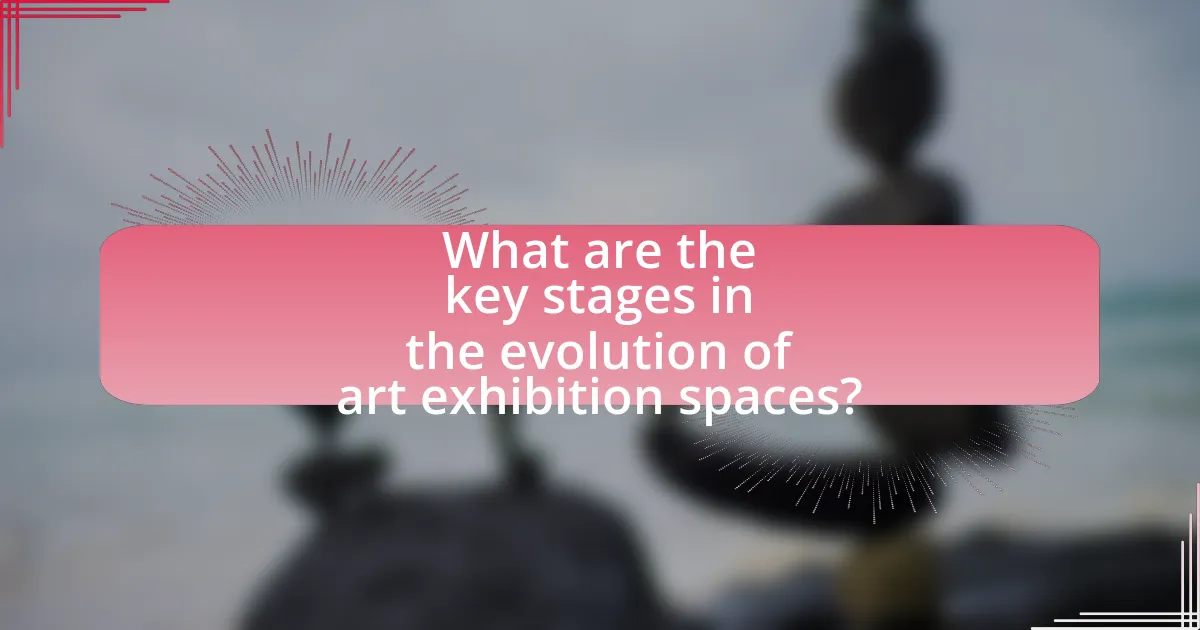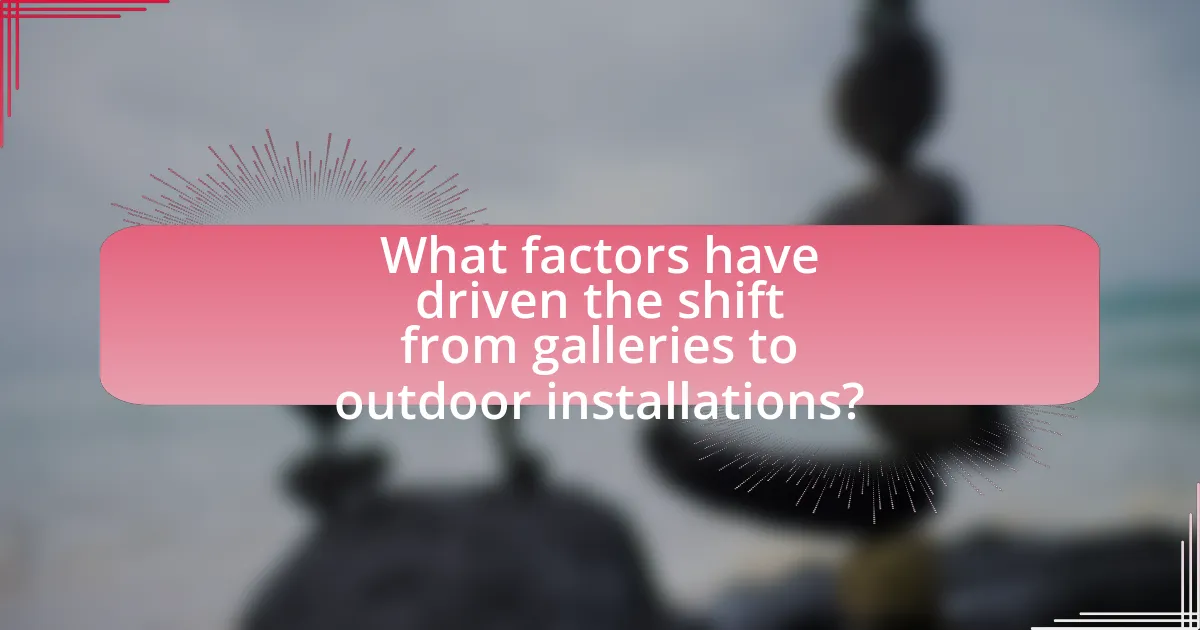The article examines the evolution of art exhibition spaces, tracing their development from private galleries in the Renaissance to contemporary outdoor installations. It highlights key stages, including the establishment of public museums in the 18th and 19th centuries, the emergence of alternative spaces in the late 20th century, and the increasing prominence of outdoor art. The discussion encompasses the architectural features of early galleries, the evolving role of curators, and innovations in exhibition design influenced by modernism and technology. Additionally, it explores how outdoor installations have transformed public engagement with art, driven by cultural trends and the rise of social media, while also addressing future trends in art exhibition spaces.

What are the key stages in the evolution of art exhibition spaces?
The key stages in the evolution of art exhibition spaces include the emergence of private galleries in the Renaissance, the establishment of public museums in the 18th and 19th centuries, the rise of alternative spaces in the late 20th century, and the development of outdoor installations in contemporary art. Private galleries began showcasing individual artists’ works, allowing for greater visibility and patronage. Public museums expanded access to art for the general public, with institutions like the Louvre opening in 1793. Alternative spaces emerged as artists sought to challenge traditional exhibition formats, often in non-commercial venues. Finally, outdoor installations have gained prominence, allowing art to engage with public spaces and communities, exemplified by projects like Christo and Jeanne-Claude’s “The Gates” in Central Park in 2005. Each stage reflects changing societal values and the evolving relationship between art and its audience.
How did traditional galleries shape the early art exhibition landscape?
Traditional galleries significantly shaped the early art exhibition landscape by providing structured environments for artists to showcase their work to the public. These galleries established formal exhibition practices, including curation, display techniques, and the organization of art shows, which helped to legitimize artists and their creations. For instance, the establishment of the Salon in Paris in the 18th century served as a pivotal platform for artists, influencing public taste and art criticism. This structured approach allowed galleries to become cultural hubs, fostering relationships between artists, collectors, and the public, which ultimately contributed to the professionalization of the art market.
What architectural features defined early galleries?
Early galleries were primarily defined by features such as high ceilings, large windows, and open floor plans. These architectural elements facilitated natural light, which was essential for showcasing artworks effectively. High ceilings allowed for the display of larger pieces and created an expansive atmosphere, while large windows provided ample daylight, enhancing the visibility of colors and details in the art. Open floor plans encouraged a fluid movement through the space, promoting an immersive experience for visitors. Historical examples, such as the Louvre’s early exhibition spaces, illustrate these characteristics, demonstrating their importance in the evolution of art exhibition environments.
How did the role of curators evolve in traditional galleries?
The role of curators in traditional galleries evolved from mere custodians of art to strategic facilitators of cultural dialogue and audience engagement. Initially, curators primarily focused on the organization and preservation of artworks, selecting pieces for exhibitions based on aesthetic criteria. Over time, as the art world expanded and diversified, curators began to adopt a more dynamic role that included interpreting art within broader social, political, and historical contexts. This shift was influenced by the rise of contemporary art movements and the increasing importance of audience interaction, leading curators to incorporate educational programs, community outreach, and thematic exhibitions that resonate with diverse audiences. The evolution reflects a broader trend in the art world towards inclusivity and accessibility, emphasizing the curator’s role as a mediator between artists, artworks, and the public.
What innovations emerged in the 20th century for art exhibitions?
Innovations in the 20th century for art exhibitions included the introduction of multimedia installations, interactive exhibits, and the use of technology such as digital projections and virtual reality. These advancements transformed traditional exhibition formats by allowing artists to engage audiences in new ways. For instance, the 1960s saw the rise of immersive environments, exemplified by artists like Yayoi Kusama, who created installations that envelop viewers in her unique artistic vision. Additionally, the incorporation of sound and video elements became prevalent, as seen in the works of Nam June Paik, who is often regarded as the father of video art. These innovations not only expanded the boundaries of artistic expression but also redefined the viewer’s experience within exhibition spaces.
How did modernism influence exhibition design?
Modernism significantly influenced exhibition design by prioritizing minimalism, functionality, and the integration of new materials and technologies. This movement, which emerged in the late 19th and early 20th centuries, emphasized clean lines and open spaces, leading to the creation of galleries that focused on the artwork rather than ornate architecture. For instance, the Bauhaus school, founded in 1919, advocated for the unity of art and technology, which resulted in innovative exhibition layouts that enhanced viewer engagement. Additionally, modernist designers like Le Corbusier and Mies van der Rohe utilized industrial materials such as steel and glass, allowing for flexible and adaptable exhibition spaces that could accommodate various artistic expressions. This shift not only transformed how art was displayed but also influenced the overall visitor experience, making exhibitions more accessible and interactive.
What role did technology play in transforming exhibition spaces?
Technology has significantly transformed exhibition spaces by enhancing interactivity and accessibility for audiences. Innovations such as virtual reality, augmented reality, and digital displays allow visitors to engage with artworks in immersive ways, creating a more dynamic experience. For instance, museums have adopted interactive kiosks and mobile applications that provide additional context and information about exhibits, thereby enriching the visitor experience. Furthermore, advancements in lighting and sound technology have enabled curators to create more atmospheric environments that complement the artworks on display. The integration of these technologies has not only attracted larger audiences but also facilitated remote access to exhibitions through online platforms, expanding the reach of art beyond physical locations.
How have outdoor installations changed the perception of art exhibitions?
Outdoor installations have transformed the perception of art exhibitions by making art more accessible and engaging to a broader audience. Unlike traditional gallery settings, outdoor installations invite interaction and immersion, allowing viewers to experience art in diverse environments. This shift has democratized art appreciation, as public spaces often attract individuals who may not typically visit galleries, thereby expanding the audience base. For instance, events like the annual “Sculpture by the Sea” in Australia showcase large-scale artworks along coastal paths, drawing in over 500,000 visitors each year, illustrating the significant impact of outdoor installations on public engagement with art.
What are the defining characteristics of outdoor art installations?
Outdoor art installations are characterized by their integration with the natural environment, large scale, and interactive elements. These installations often utilize public spaces, allowing for accessibility and engagement with a diverse audience. The use of durable materials is common, ensuring longevity against weather conditions. Additionally, outdoor art installations frequently encourage viewer participation, transforming passive observation into active involvement. For instance, works like Christo and Jeanne-Claude’s “The Gates” in Central Park exemplify how outdoor installations can alter perceptions of familiar landscapes while inviting public interaction.
How do outdoor installations engage with public spaces differently than galleries?
Outdoor installations engage with public spaces by directly interacting with the environment and the community, unlike galleries that confine art within four walls. Outdoor installations often utilize natural landscapes, urban settings, and public infrastructure, allowing for a broader audience engagement and spontaneous interactions. For example, installations like Christo and Jeanne-Claude’s “The Gates” in Central Park transformed a public space into an immersive art experience, attracting over four million visitors. This accessibility contrasts with galleries, which typically require visitors to enter a specific location, limiting exposure to a more select audience. Thus, outdoor installations democratize art by inviting diverse participation and fostering a sense of community connection.

What factors have driven the shift from galleries to outdoor installations?
The shift from galleries to outdoor installations has been driven primarily by the desire for increased accessibility and audience engagement. Outdoor installations allow art to reach a broader audience, as they are often free and located in public spaces, contrasting with the traditional gallery setting that may limit access due to admission fees or location. Additionally, the rise of social media has encouraged artists to create works that are visually striking and shareable, enhancing public interaction and visibility. The trend towards environmental consciousness has also influenced this shift, as outdoor installations often incorporate natural elements and address ecological themes, resonating with contemporary societal concerns.
Why are artists increasingly choosing outdoor spaces for their work?
Artists are increasingly choosing outdoor spaces for their work due to the desire for greater visibility and engagement with diverse audiences. Outdoor environments provide a dynamic backdrop that enhances the interaction between art and nature, allowing for larger installations and immersive experiences. Additionally, the shift towards outdoor spaces is supported by trends in contemporary art that prioritize accessibility and community involvement, as seen in events like the Venice Biennale, which often features outdoor installations that attract a wide range of viewers. This trend reflects a broader movement in the art world towards inclusivity and public engagement, making art more approachable and relevant to everyday life.
How does accessibility influence the choice of exhibition space?
Accessibility significantly influences the choice of exhibition space by determining the ability of diverse audiences to engage with the artwork. Spaces that are easily accessible, such as those with ramps, elevators, and clear signage, attract a wider range of visitors, including individuals with disabilities, families with strollers, and the elderly. Research indicates that venues prioritizing accessibility can increase attendance by up to 30%, as seen in studies conducted by the National Endowment for the Arts, which highlight the correlation between accessibility features and visitor numbers. Therefore, the selection of an exhibition space often hinges on its capacity to accommodate all potential visitors, ensuring inclusivity and maximizing audience reach.
What impact does the environment have on the artwork displayed outdoors?
The environment significantly influences the artwork displayed outdoors by affecting its visibility, durability, and interaction with the audience. Natural elements such as light, weather, and surrounding landscapes can enhance or detract from the artwork’s intended message. For instance, sunlight can alter the colors and shadows of a piece, while rain or humidity can cause deterioration, impacting the artwork’s longevity. Additionally, the context provided by the environment can create a dialogue between the artwork and its surroundings, as seen in installations like Christo and Jeanne-Claude’s “The Gates” in Central Park, which transformed the park’s landscape and engaged viewers in a unique experience.
What cultural trends have contributed to this evolution?
Cultural trends such as the rise of urbanization, the emphasis on experiential art, and the increasing influence of social media have significantly contributed to the evolution of art exhibition spaces from traditional galleries to outdoor installations. Urbanization has led to a demand for public art that engages communities and transforms urban landscapes, making art more accessible. The emphasis on experiential art reflects a shift towards interactive and immersive experiences, encouraging artists to create installations that invite audience participation. Additionally, social media platforms have amplified the visibility of outdoor art, allowing artists to reach wider audiences and encouraging the trend of site-specific installations that resonate with contemporary cultural narratives. These trends collectively illustrate a dynamic shift in how art is experienced and appreciated in public spaces.
How has the rise of social media affected outdoor art installations?
The rise of social media has significantly increased the visibility and engagement of outdoor art installations. Artists and curators now leverage platforms like Instagram and Facebook to promote their work, leading to greater public interaction and attendance. For instance, a study by the Pew Research Center found that 69% of adults in the U.S. use social media, which facilitates the sharing of images and experiences related to outdoor art, thus enhancing its reach. Additionally, outdoor installations are often designed with social media in mind, incorporating elements that encourage visitors to take photos and share them online, further amplifying their impact.
What role does community engagement play in the success of outdoor exhibitions?
Community engagement is crucial for the success of outdoor exhibitions as it fosters a sense of ownership and connection among local audiences. Engaged communities are more likely to participate actively, attend events, and promote the exhibitions, leading to higher visitor numbers and increased visibility. Research indicates that outdoor exhibitions that involve community input and collaboration see a 30% increase in attendance compared to those that do not engage the community. This involvement not only enhances the relevance of the exhibition to the local context but also encourages diverse perspectives, enriching the overall experience for attendees.

What are the future trends in art exhibition spaces?
Future trends in art exhibition spaces include increased integration of technology, a focus on sustainability, and the rise of immersive experiences. Art institutions are adopting virtual and augmented reality to enhance visitor engagement, as seen in exhibitions like the Van Gogh immersive experience, which attracted millions globally. Additionally, sustainability is becoming a priority, with galleries implementing eco-friendly practices, such as using recycled materials and energy-efficient lighting, reflecting a broader societal shift towards environmental responsibility. Furthermore, outdoor installations are gaining popularity, allowing artists to reach wider audiences and interact with public spaces, exemplified by initiatives like the High Line in New York City, which transformed an abandoned railway into a vibrant art venue. These trends indicate a significant evolution in how art is presented and experienced.
How might technology further influence art exhibitions in the coming years?
Technology will significantly influence art exhibitions in the coming years by enhancing interactivity and accessibility through virtual and augmented reality. These technologies allow artists to create immersive experiences that engage audiences in novel ways, such as virtual galleries that can be accessed globally, breaking geographical barriers. For instance, the use of augmented reality apps can enable viewers to interact with artworks in real-time, providing additional layers of information and context. Furthermore, data analytics can help curators understand audience preferences and tailor exhibitions accordingly, improving visitor engagement. The integration of blockchain technology may also revolutionize art ownership and provenance tracking, ensuring authenticity and transparency in transactions. These advancements indicate a shift towards more dynamic and inclusive art experiences.
What advancements in virtual reality could change the exhibition experience?
Advancements in virtual reality, such as improved immersive technologies, enhanced interactivity, and realistic simulations, could significantly change the exhibition experience. These technologies allow visitors to engage with art in a more profound way, enabling them to explore virtual galleries and installations from anywhere in the world. For instance, the use of haptic feedback devices can create tactile sensations, making the experience more engaging and lifelike. Additionally, the integration of artificial intelligence can personalize the exhibition experience by curating content based on individual preferences. Studies have shown that immersive experiences can increase emotional engagement and retention of information, which supports the effectiveness of these advancements in transforming how art is experienced.
How can augmented reality enhance outdoor installations?
Augmented reality can enhance outdoor installations by providing interactive and immersive experiences that engage viewers in real-time. This technology allows users to visualize digital content overlaid on physical installations, creating a dynamic interaction that can convey additional layers of meaning or context. For instance, studies have shown that augmented reality can increase visitor engagement by up to 70%, as it encourages exploration and interaction with the artwork. By integrating multimedia elements such as animations, audio, and information about the artist or the piece, augmented reality transforms passive viewing into an active experience, thereby enriching the overall impact of outdoor installations.
What best practices should artists consider when planning outdoor installations?
Artists should consider environmental factors, audience engagement, and site-specificity when planning outdoor installations. Environmental factors include assessing weather conditions, natural light, and the surrounding landscape to ensure the artwork is durable and visually effective. Audience engagement involves creating interactive elements that invite participation and foster a connection between the artwork and viewers. Site-specificity requires artists to understand the cultural and historical context of the location, ensuring that the installation resonates with its surroundings and the community. These best practices enhance the impact and longevity of outdoor installations, as evidenced by successful projects like Christo and Jeanne-Claude’s “The Gates,” which effectively integrated environmental and cultural considerations.
How can artists effectively engage with their audience in outdoor settings?
Artists can effectively engage with their audience in outdoor settings by creating interactive installations that invite participation. These installations can include elements such as live performances, workshops, or immersive experiences that encourage audience involvement. For instance, studies show that interactive art can increase viewer engagement by up to 70%, as it fosters a sense of connection and personal investment in the artwork. Additionally, utilizing the natural environment as part of the artwork can enhance the sensory experience, making it more memorable and impactful.
What logistical considerations are essential for successful outdoor exhibitions?
Successful outdoor exhibitions require careful planning of site selection, weather contingencies, and accessibility. Site selection involves choosing a location that accommodates the exhibition’s theme and audience, ensuring adequate space for installations and visitor flow. Weather contingencies are crucial, as outdoor events are susceptible to rain, wind, and extreme temperatures; thus, having tents or alternative indoor spaces can mitigate these risks. Accessibility considerations include ensuring that the venue is reachable for all attendees, including those with disabilities, which may involve providing ramps, clear signage, and transportation options. These logistical elements are essential for creating a seamless experience that enhances visitor engagement and satisfaction.















